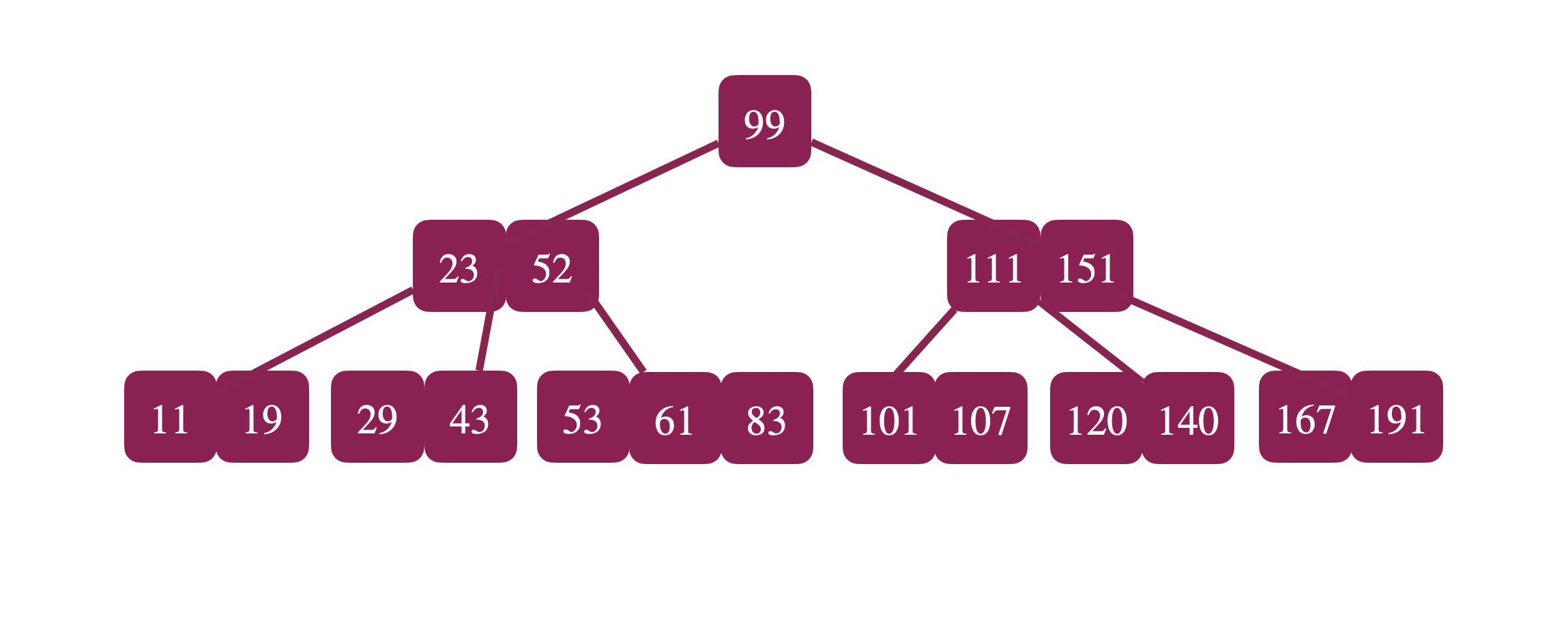 B-trees are balanced search trees. While red-black trees are also balanced search trees, their branching factor is only 2. B-trees differ in that their branching factor can be really large. The number of keys in a B-tree node determines the number of its children. A node with \(n\) keys have \(n+1\) children. This way, each child handles a specific range of keys in its parent.
B-trees are balanced search trees. While red-black trees are also balanced search trees, their branching factor is only 2. B-trees differ in that their branching factor can be really large. The number of keys in a B-tree node determines the number of its children. A node with \(n\) keys have \(n+1\) children. This way, each child handles a specific range of keys in its parent.
Motivation
But why do we need a large branching factor? The motivation behind this idea has to do with minimizing disk I/O operations. Data on disk can be read in pages and so if each node’s size is a whole page in which we pack a lot of keys in, we can then minimize the number of read operations.
Specifications
-
Let \(x\) be an internal node and let \(n\) be the number of keys stored at \(x\). \(x\) must have \(n+1\) children. Furthermore, the keys are stored in non-decreasing order. Leaf nodes on the other hand have no children. No restrictions on the number of children of the root.
-
The minimum degree of a b-tree is an integer, \(t\) such that \(t \geq 2\). Every node besides the root must have between \(t-1\) and \(2t-1\) keys. This also implies that it must have at least \(t\) children and at most \(2t\) children. If the tree is not empty, the root must be at least have 1 key.
-
The keys in each node are stored in non-decreasing order. The keys also define the range of keys stored in the children subtrees below. In the above figure, We see the range [0,23] defines the range for the child keys below [11,19]. Similarly [23,53] defines the range for the next child’s keys [29,43].
Why are B-trees balanced?
To see why B-trees are balanced, we will prove that the maximum height of a b-tree of degree \(t\) with \(n\) keys is \(O(\log_t(n))\).
Proof: At level 0, the root must at least have 1 key. At level 1 we must have two children, each of which must have at least \(t-1\) keys, so the total number of keys is \(2(t-1)\). Each of these children will have at least \(t\) children and so at level 2, we should have \(2t(t-1)\) keys. Therefore, the total number of keys is at least
Search
Similar to searching in a binary tree, we descend down the tree and select the right branch based on the key value. In \(B\)-trees, each node has has \(n\) keys and so this means that we have \(n+1\) children or branches. We need to compare our key with these \(n\) keys to find the right child/branch to descend into.

Each node stores an array of its keys. In the figure above, suppose we’re currently at node $x$ during the search and suppose we’re searching for \(k = 84\). We first want to find the smallest index such that \(k \leq keys[i]\). For \(k=84\), the smallest index is \(i = 3\). 101 is the smallest key that is larger than 84. We then have several cases:
- \(k = keys[i]\). This is great, we just return \(x\) with the index of the key \(i\).
- \(x\) is a leaf node so we return NULL.
- \(k \neq keys[i]\). \(k\) falls somewhere between the key at index \(i-1\) and the key at index \(i\). This range corresponds to the child at index \(i\). We call search again on the \(i\)th child.
// search a b-tree of degree t
search(x, k) {
int i = 0;
// search for the smallest index such that k <= keys[i]
// this means k will be in the range (keys[i-1], keys[i])
while (i < x.n && k > x.keys[i]) {
i++;
}
// three possible cases
if (index < x.n && x.keys[i] == k) { // key found
return (x, i);
} else if (x.leaf) { // x is a leaf node
return NULL; // no more possible matches
} else {
return search(x.child[i], k);
}
How long does Search take?
Note that in the above method, we were using a linear search to find the right key. For a tree of degree \(t\), each node can have at most \(2t-1\) keys. So this search takes \(O(t)\) time. Since the tree height is \(O(log_t(n))\) then the total cost is \(O(t\log_t(n))\).
Suppose we instead use binary search to find the key. This means that each search will now take \(O(\log(t))\) time and so the total cost becomes \(O(\log(t)\log_t(n))\). Re-writing \(\log_t(n)\) as \(\frac{\log(n)}{\log(t)}\), we see that the total time is \(O(\log(n))\).
Insert
TODO
Delete
TODO
References
- CLRS
- Stanford CS166